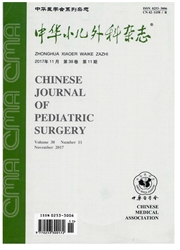

 中文摘要:
中文摘要:
目的通过检测多药耐药基因蛋白在儿童颅内肿瘤组织和正常脑组织的表达,探讨颅内肿瘤耐药机制。方法采用免疫组织化学技术检测30例儿童颅内肿瘤和5例正常脑组织中P-糖蛋白(P-glycoprotein,P-gp)、多药耐药相关蛋白(multidrug resistance-associated protein,MRP)、肺耐药相关蛋白(lung resistance-related protein,LRP)、DNA拓扑异构酶Ⅱ(topoisomerase Ⅱ,topoⅡ)和谷胱甘肽-S-转移酶(glutathione-s-transferase-π,GST-π)5种多药耐药基因蛋白表达强度和分布。结果P-gp主要表达于毛细血管管壁和管周组织,而在肿瘤细胞表达较低。其他4种多药耐药基因蛋白在毛细血管管壁不表达。结论P-gp在血脑屏障中的神经胶质细胞终足部分参与了对化疗药物的阻滞,增加了颅内肿瘤的耐药性。
 英文摘要:
英文摘要:
Objective To investigate the mechanism of the multidrug resistance in intracranial tumors. Methods Immunohistochemistry was used to detect the expression and location of P-glycoprotein ( P-gp), multidrug resistance-associated protein (MRP), Lung resistance-related protein (LRP), Topoisomerase Ⅱ (TopoⅡ) and Glutathione-S-transferase-π(GST-π) in 30 patients' tumor tissues and 5 normal brain tissues. Results The high expression of P-gp was detected in vessel walls and the tissue around vessels. However, the expression of P-gp was low in tumor cells. The expression of the other 4 multidrug resistance proteins couldn't be observed in vessel walls. Conclusions The chemotherapeutics drugs were interrupted in the end-feet of neuroepithelial cells of the blood-brain barrier by P-gp, which weakened the chemotherapeutic effect.
 同期刊论文项目
同期刊论文项目
 同项目期刊论文
同项目期刊论文
 期刊信息
期刊信息
